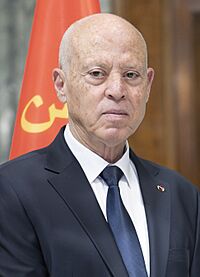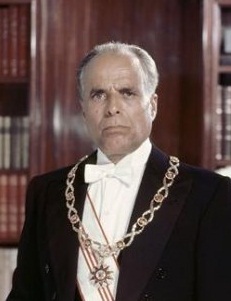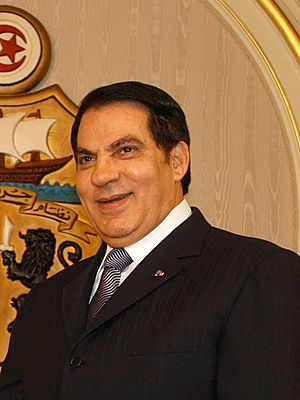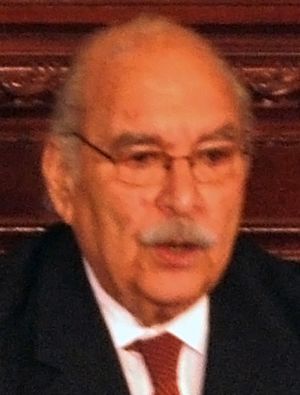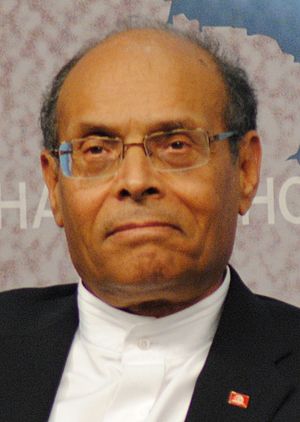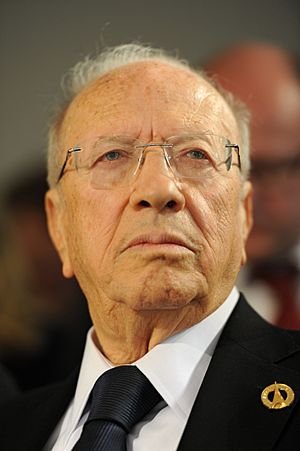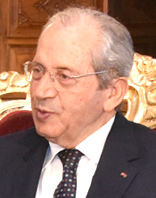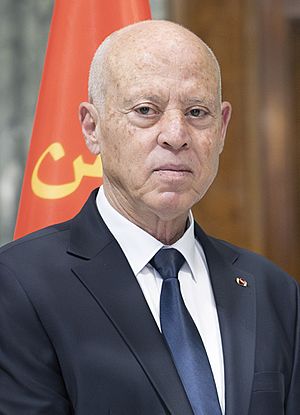President of Tunisia facts for kids
Quick facts for kids President of the Republic of Tunisia |
|
|---|---|

Presidential standard
|
|

Presidential seal
|
|
| Executive branch of the Government of the Republic of Tunisia Head of state of the Republic of Tunisia |
|
| Style | His Excellency |
| Residence | Carthage Palace, Carthage |
| Term length | Five years,
renewable once
|
| Constituting instrument | Constitution of Tunisia (2022) |
| Inaugural holder | Habib Bourguiba |
| Formation | 25 July 1957 |
| Salary | US$90,380 annually |
The President of Tunisia is the main leader of the country. This official title is the President of the Republic of Tunisia. The president is the head of state and leads the government. They also act as the commander-in-chief of Tunisia's armed forces.
The president is chosen by the people in an election. They serve for five years and can be re-elected once. The first president of Tunisia was Habib Bourguiba, who started his role on July 25, 1957. He was in power for 30 years. In 1987, his prime minister, Zine El Abidine Ben Ali, took over. Ben Ali was president for 23 years until the Tunisian revolution in 2011.
After Ben Ali, Fouad Mebazaa became an interim president. Then, Moncef Marzouki was elected in 2011. He was the first president chosen in a more democratic way. In 2014, Beji Caid Essebsi won the presidential election. He was the second president directly elected by the people. He passed away in 2019, and Mohamed Ennaceur became interim president. The current president of Tunisia is Kais Saied, who has been in office since October 23, 2019.
Contents
History of Tunisia's Presidents
Since Tunisia became a republic in 1957, it has had several presidents. The country gained independence from France in 1956.
Early Leaders and Changes
Habib Bourguiba was Tunisia's first president. He became president after the country was declared a republic in 1957. He was elected officially in 1959. In 1975, he was named president for life. However, he was removed from office in 1987 by his prime minister, Zine El Abidine Ben Ali. This happened because Bourguiba was declared medically unable to continue.
Ben Ali then became president. He was elected in 1989 and stayed in power until 2011. He was forced to leave during a large uprising against his rule.
Moving Towards Democracy
For a long time, Tunisia did not have a strong democracy. Presidential elections often showed very high results for the ruling party. This made the elections seem less fair to many people. Before 1999, it was very hard for anyone not from the main party to even run for president.
The original constitution gave the president a lot of power. They were almost like a dictator. In 1975, President Bourguiba was even named president for life. Later, a rule was added that a president could only serve three five-year terms. This rule was removed in 2002.
New Rules for Presidents
The Tunisian Constitution of 2014 changed things. It kept the president as the main leader but added many rules to prevent too much power. Now, a president can only serve two five-year terms. The constitution also says this rule cannot be changed to allow more terms.
Under the current constitution, the president is mainly in charge of foreign policy, defense, and national security. The prime minister handles domestic policy. After Ben Ali left in 2011, there was some confusion about who should be acting president. Eventually, Fouad Mebazaa, the Speaker of the Chamber of Deputies, became the acting president. Later, Moncef Marzouki was elected as interim president by a new assembly.
The 2022 Tunisian constitutional referendum made the president even more powerful. It limited the role of the parliament.
How Tunisian Presidents Are Elected
The president is chosen by all eligible voters in an election. This happens in the last 60 days of the previous president's term.
Who Can Be President?
To run for president, a person must be a Tunisian citizen and at least 35 years old. They must also be of Muslim faith. If elected, candidates must give up any other nationalities they might have.
The Voting Process
Tunisia uses a two-round election system. This means if no candidate gets more than half of the votes in the first round, a second round is held. The two candidates with the most votes from the first round compete in the second round. The one who gets the most votes in the second round becomes president.
If a candidate dies before the election, new dates are set for the election within 45 days. A president cannot serve more than two full terms, even if they are not consecutive. If a president resigns, their term is still counted as a full term.
List of Tunisian Presidents
| No. | Portrait | Name | Start of term | End of term | Political affiliation | Notes |
|---|---|---|---|---|---|---|
| 1 | Habib Bourguiba (1903–2000) |
25 July 1957 | 7 November 1987 | Neo-Destour | Bourguiba was the Prime Minister before becoming president. He declared Tunisia a republic and was elected president. He was later named president for life in 1975. His prime minister, Zine El Abidine Ben Ali, removed him from office in 1987. | |
| SDP | ||||||
| 2 | Zine El Abidine Ben Ali (1936–2019) |
7 November 1987 | 14 January 2011 | SDP | Ben Ali was Prime Minister and Interior Minister under President Bourguiba. He took over when Bourguiba was removed. He faced big protests in 2010 and left the presidency in 2011, going to Saudi Arabia. | |
| DCR | ||||||
| (-) | Fouad Mebazaa (1933–2025) |
15 January 2011 | 13 December 2011 | DCR | As the Speaker of the Chamber of Deputies, Mebazaa became interim president after Ben Ali left. He helped set up the Constituent Assembly. | |
| Independent | ||||||
| 3 | Moncef Marzouki (b. 1945) |
13 December 2011 | 31 December 2014 | CFR | Marzouki was the first president after the Tunisian Revolution. He was also the first president not to come from the ruling party since independence. | |
| 4 | Beji Caid Essebsi (1926–2019) |
31 December 2014 | 25 July 2019 † | Nidaa Tounes | Caïd Essebsi won the 2014 presidential elections. He was the first president elected directly by the people after the revolution. He passed away while in office in 2019. | |
| (-) | Mohamed Ennaceur (b. 1934) |
25 July 2019 | 23 October 2019 | Nidaa Tounes | He served as interim president for a short time after President Essebsi passed away. | |
| 5 | Kais Saied (b. 1958) |
23 October 2019 | present | Independent | Saïed won the 2019 presidential election. He is the first independent president of Tunisia. He is also the first president born after Tunisia gained independence. In 2021, he suspended Parliament and changed the government, leading to a new constitution in 2022. |
Latest Election Results
The most recent presidential election in Tunisia was in 2024.
| Candidate | Party | |||||
|---|---|---|---|---|---|---|
| Votes | % | |||||
| Kais Saied | Independent | 2,438,954 | 90.69 | |||
| Ayachi Zammel | Azimoun | 197,551 | 7.35 | |||
| Zouhair Maghzaoui | People's Movement | 52,903 | 1.97 | |||
| Blank votes | 34,187 | 1.22 | ||||
| Invalid votes | 84,953 | 3.02 | ||||
| Total | 3,465,184 | 100.00 | ||||
| Registered voters/turnout | 9,753,217 | 28.80 | ||||
| Source: Independent High Authority for Elections (preliminary) | ||||||
See also


